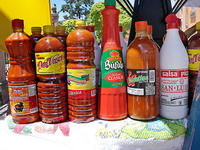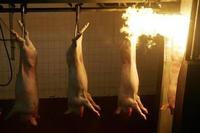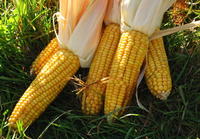-
Climate change was proximate, not primary, cause of 2012 Great Plains drought: study

From May to July 2012, the Great Plains region of the western United States faced a powerful and unpredicted drought. Following seven months of normal rainfall, the drought was one of the largest deviations from seasonal precipitation rates seen in the region since observations began in 1895. Researches find that the drought fell within the bounds of natural atmospheric variability. The strength of the drought, they suggest, was a consequence of the multiple complex nonlinear systems that make up the climate system and did not critically depend on the existence of a strong external forcing.
-
-
Imported food: Shifting from catching problems at the border to preventing them at the source
The Association of Food and Drug officials (AFDO) has published its guidance document for improving imported food safety. The document, entitled “Issues and Concerns with Imported Foods,” was released ahead of the U.S Food and Drug Administration’s (FDA) release of two rules on the same issue. The FDA aims to shift from a regulatory system that focuses on catching problems at the border and into a prevention system to correct issues before they reach the American border.
-
-
Climate change threatens world food security
The last few decades have witnessed a substantial decline in the number of hungry people worldwide. Since 2007, however, progress has slowed and world food supply and demand have been precariously balanced — climate change threatens to tip this balance, most dramatically in the poorer areas of the world.
-
-
Lawmakers criticize FDA, CDC for Cyclospora outbreak foot-dragging
Lawmakers want to know why it has taken so long for food-safety authorities to respond to the cyclospora outbreak which, so far, has sickened at least 418 people in sixteen states. They also want to know why the FDA and CDC have been tight-lipped about the specific products carrying the parasite — health authorities in Nebraska and Iowa have pointed to bagged salad containing romaine and iceberg lettuce as well as carrots and cabbage as the source – and who is the manufacturer of the contaminated products.
-
-
University of Minnesota in new food-safety partnerships with China
The National Center for Food Protection and Defense (NCFPD), a DHS center which has been housed at the College of Veterinary Medicine of the University of Minnesota since 2004, and the Chinese Academy of Inspection and Quarantine (CAIQ) have signed a memorandum of understanding on food safety, protection, and defense issues. Both organizations will work to prevent and combat intentional contamination of the food supply for either economic or terroristic reasons.
-
-
Well water contaminants highest near natural gas drilling: study
A new study of 100 private water wells in and near the Barnett Shale showed elevated levels of potential contaminants such as arsenic and selenium closest to natural gas extraction sites. Researchers believe the increased presence of metals could be due to a variety of factors including: industrial accidents such as faulty gas well casings; mechanical vibrations from natural gas drilling activity disturbing particles in neglected water well equipment; or the lowering of water tables through drought or the removal of water used for the hydraulic fracturing process. Any of these scenarios could release dangerous compounds into shallow groundwater.
-
-
North Carolina’s biothreat warning system receives funding
The North Carolina Bio-Preparedness Collaborative (NCB-Prepared), a project to develop an early warning system to detect biothreats, has received $3 million in funding. The goal of NCB-Prepared project is to develop a statewide system that can detect and alert health officials and first responders within hours of an outbreak indicating a bioterror attack, contagious disease or illness, food-borne illness, and other biothreats.
-
-
The hidden dangers of south-of-the-border hot sauce

In the last decade, the U.S Food and Drug Administration (FDA) issued several warnings about and recalls of imported food products that exceed federal standards for lead. Products containing chili peppers and salt, such as Mexican-style candies, were often suspected as sources of lead contamination. Researchers now find elevated lead levels in some hot sauces imported from Mexico. The researchers urge USDA and the FDA to develop enforceable screening standards for hot sauce.
-
-
New technology enables crops to take nitrogen directly from the air
Nitrogen fixation, the process by which nitrogen is converted to ammonia, is vital for plants to survive and grow. Only a very small number of plants, however, most notably legumes (such as peas, beans, and lentils) have the ability to fix nitrogen from the atmosphere with the help of nitrogen fixing bacteria. The vast majority of plants have to obtain nitrogen from the soil, and for most crops currently being grown across the world, this also means a reliance on synthetic nitrogen fertilizer. Nitrogen pollution is a major problem however, and efforts to deal with it are costly. Researchers have developed a method of putting nitrogen-fixing bacteria into the cells of plant roots. The implications for food production are enormous.
-
-
Food safety, farm groups oppose Smithfield sale

A group of farm and food safety advocates is pushing federal regulators to prevent the sale of Smithfield Foods to Chinese food giant Shuanghui International Holdings. The coalition argues the sale could hurt domestic food safety, cause economic damage in rural communities, and could be a threat to national security.
-
-
Climate forecasts predict crop failures
Climate data can help predict some crop failures several months before harvest, according to a new study. Scientists found that in about one-third of global cropland, temperature and soil moisture have strong relationships to the yield of wheat and rice at harvest. For those two key crops, a computer model could predict crop failures three months in advance for about 20 percent of global cropland.
-
-
Pathogen which caused Irish potato famine even more virulent now
The plant pathogen which caused the Irish potato famine in the 1840s lives on today, but with a different genetic blueprint and an even larger arsenal of weaponry to harm and kill plants. An estimated $6.2 billion is spent each year on crop damage and attempts to control the pathogen.
-
-
Provision in House farm bill could postpone FDA food safety regulations
The largest overhaul of food safety regulations in the United States in more than five decades could be in danger as a result of an amendment in the farm bill that passed the House last week and sent to the Senate Tuesday. The House farm bill (H.R. 2642)has a provision requiring the Food and Drug Administration (FDA) to direct a “scientific and economic analysis” of the regulations under the Food Safety and Modernization Act (FSMA).
-
-
Disruption of maize trade would have global ramifications

Maize is at the center of global food security as growing demands for meat, fuel uses, and cereal crop demands increase the grain’s pivotal importance in diets worldwide. Disruptions to U.S. exports of maize (corn) could pose food security risks for many U.S. trade partners due to the lack of trade among other producing and importing nations. This is particularly true in nations like Mexico, Japan, and South Korea that have yet to diversify their sources.
-
-
Addresses trade-offs between food security, greenhouse gas emissions
Agriculture and land use change contributed about 1/3 of total human greenhouse gas emissions in the past decade, through crop cultivation, animal production, and deforestation. Improving agricultural productivity could help cut greenhouse gas emissions from agriculture, a new study shows, but sustainable farming methods are key.
-
- All
- Regional
- Water
- Biometrics
- Borders/Immig
- Business
- Cybersecurity
- Detection
- Disasters
- Government
- Infrastructure
- International
- Public health
- Public Safety
- Communication interoperabillity
- Emergency services
- Emergency medical services
- Fire
- First response
- IEDs
- Law Enforcement
- Law Enforcement Technology
- Military technology
- Nonlethal weapons
- Nuclear weapons
- Personal protection equipment
- Police
- Notification /alert systems
- Situational awareness
- Weapons systems
- Sci-Tech
- Sector Reports
- Surveillance
- Transportation
Advertising & Marketing: advertise@newswirepubs.com
Editorial: editor@newswirepubs.com
General: info@newswirepubs.com
2010-2011 © News Wire Publications, LLC News Wire Publications, LLC
220 Old Country Road | Suite 200 | Mineola | New York | 11501
Permissions and Policies
Editorial: editor@newswirepubs.com
General: info@newswirepubs.com
2010-2011 © News Wire Publications, LLC News Wire Publications, LLC
220 Old Country Road | Suite 200 | Mineola | New York | 11501
Permissions and Policies
